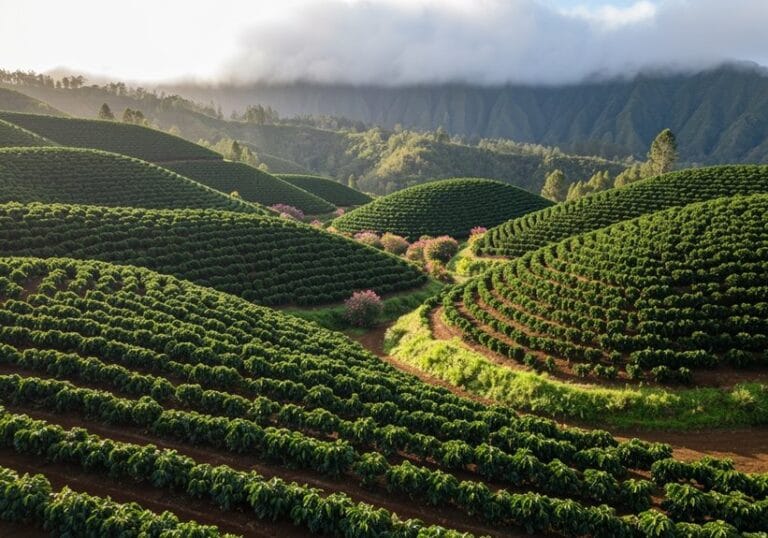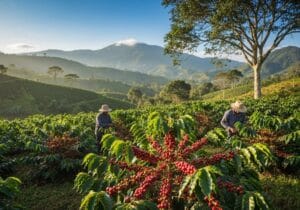Hawaii’s coffee regions are like a treasure map of flavors waiting to be discovered! You’ve got Kona, where the coffee is all smooth and balanced—think cozy vibes for your morning cup. Then there’s Puna, bursting with bold acidity that’ll knock your socks off! With volcanic soils and unique microclimates, each region adds its own zing to every sip. And let’s not forget the quirky coffee varieties, which can surprise even the biggest coffee snob! Want to know more? Stick around!
Key Takeaways
- Hawaii’s coffee regions, including Kona, Ka’u, Hamakua, and Puna, each offer unique flavors influenced by their specific climates and elevations.
- Kona coffee is renowned for its smoothness, while Puna coffee is characterized by its bold acidity and aromatic profile.
- Volcanic soil in Hawaii provides essential nutrients, enhancing the complexity and richness of the coffee grown in different regions.
- Each coffee region supports many small family farms, emphasizing artisanal techniques like hand-picking, which preserve quality and uniqueness.
- Coffee farming in Hawaii is not only an economic driver but also a vital part of the cultural heritage and community engagement.
Overview of Coffee Growing Regions in Hawaii
In relation to coffee growing regions in Hawaii, it’s like a tale of two (or more) very different worlds!
Envision this: Kona’s sunny, dry landscape versus Puna’s soggy, rain-soaked majesty—can you believe they both grow coffee? It’s like rain and shine having a coffee date!
Kona and Puna: where sunshine meets rain for a delightful coffee rendezvous!
Higher elevations mean more than just breathtaking views—they create unique microclimates that influence flavors. Kona has that smooth, balanced brew, while Puna’s coffee packs a punch with bold acidity that’ll make your taste buds sing! In fact, the unique wet climate of Puna is what gives its coffee those robust and daring flavor profiles.
The volcanic soils? Oh boy, they’re the secret sauce! Rich and nutrient-dense, these soils give coffee its rich complexity.
Each Hawaiian coffee region tells its own flavor story, making every sip an adventure worth exploring, one cup at a time!
Notable Hawaiian Coffee Regions
Hawaiian coffee regions are nothing short of an adventure, each with its own quirks and surprises!
Take Kona, for instance, the largest coffee-growing area in Hawaii, where around 900 farms thrive. Imagine this: coffee beans basking in nutrient-rich volcanic soil—yum!
Then there’s the Ka’u region, formerly sugarcane land, that’s now a coffee paradise, producing exceptional beans!
Oh, and don’t forget the Hamakua region, where smaller family farms keep it cozy and hand-picked.
Last but not least, Puna, the new kid on the block, flaunting its bold flavors and fragrant aromas!
Growing coffee in Hawaii isn’t just a business; it’s a flavorful journey that tantalizes taste buds and warms hearts! Who wouldn’t love that?
Unique Coffee Varieties and Their Characteristics

Coffee lovers, let’s plunge into the world of unique Hawaiian coffee varieties—because honestly, who wouldn’t want to know more about these liquid wonders? So, does Hawaii grow coffee? Absolutely! From the fruity notes of Maui Mokka to the smooth and nutty Kauai Typica, Hawaiian coffee is a rich source of flavors!
Here’s a handy table to keep track of some favorites:
| Coffee Variety | Flavor Profile |
|---|---|
| Typica | Sweet with good cupping ability |
| Catuai | Caramel, honey, and nutmeg |
| Puna Coffee | High acidity with sandalwood and cacao nibs |
Frequently Asked Questions
How Do Climate Conditions Affect Coffee Flavor in Hawaii?
Climate conditions in Hawaii affect coffee flavor by influencing bean maturation, acidity, and sweetness. Higher elevations and moderate rainfall improve complexity, while stable temperatures and volcanic soils contribute to unique flavor profiles across different regions.
What Is the Historical Significance of Coffee Cultivation in Hawaii?
The historical significance of coffee cultivation in Hawaii lies in its evolution from early attempts to successful commercialization, shaping local agriculture, fostering immigrant contributions, and establishing Hawaii, particularly Kona, as a renowned global coffee region.
Are There Any Certifications for Hawaiian Coffee?
Hawaiian coffee is certified through HDOA grading standards, which categorize beans into five grades. Furthermore, specialty certifications by the SCA and Q Grader guarantee quality benchmarks, enhancing the reputation of Hawaii’s premium coffee offerings.
How Is Hawaiian Coffee Farmed Sustainably?
Hawaiian coffee is farmed sustainably through practices like organic methods, cover cropping, and composting to improve soil health, water conservation strategies, biodiversity preservation, and waste reduction initiatives, promoting a balanced ecosystem and reducing environmental impact.
What Coffee Brewing Methods Best Highlight Hawaiian Flavors?
To best highlight Hawaiian flavors, methods like French press improve boldness, while pour-over emphasizes clarity. Traditional drip provides versatility, and espresso delivers intensity, with cold brew offering a mellow, sweet option that showcases unique characteristics.
References
- https://bigislandcoffeeroasters.com/blogs/blog/whats-the-difference-between-kau-and-kona-coffee
- https://www.royalkonacoffee.com/growing-kona-coffee-in-hawaii/rk-growing-kona-belt/
- https://maui.coffee/blogs/hawaii/common-hawaii-varieties
- https://www.gohawaii.com/islands/hawaii-big-island/things-to-do/land-activities/coffee-plantations


